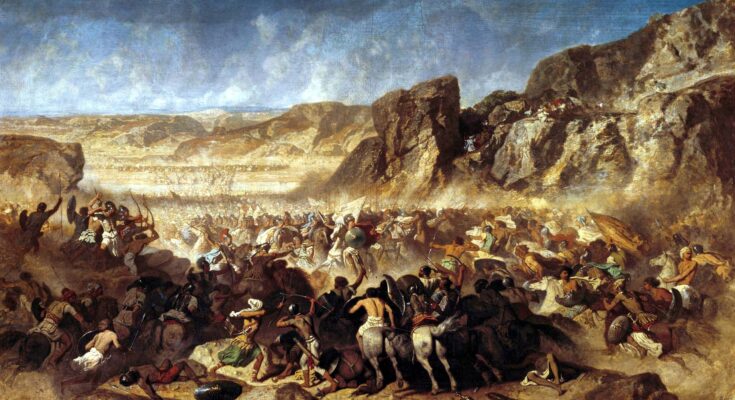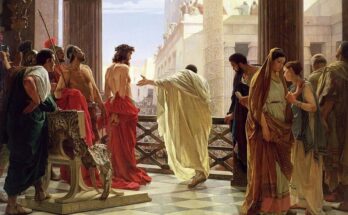Xenophon’s Anabasis follows the journey of ten thousand Greek mercenaries and their families trapped deep behind enemy lines. Their gripping escape became the stuff of legend. Interwoven within the grand saga are stories of leadership, resilience, and the relentless pursuit of home.
The march to Cunaxa: a gamble gone wrong

The adventure begins like the prelude to an epic fantasy drama. Cyrus the Younger, a Persian prince, sought to overthrow his brother, Artaxerxes II, and claim the throne.
To do so, he hired a force of Greek mercenaries, hoping their skill would tip the scales in his favor.
Xenophon, an Athenian who would later lead this force, was part of this contingent. Xenophon wasn’t just any soldier. He was a student of Socrates and a man deeply rooted in Athenian politics. But when the opportunity came to join Cyrus, he couldn’t resist.
The Greeks set off from Sardeis in 401 BC, full of hope and ambition, their sights set on the riches of the Persian Empire.
However, like Aristotle’s view on what makes a compelling narrative, expectations are immediately subverted, setting the stage for the protagonist’s actual journey.
At the Battle of Cunaxa, Cyrus was killed, leaving the Greek mercenaries leaderless and stranded in a foreign land. They were deep in the heart of Persia, surrounded by hostile forces and far from home.
The situation was dire, and their only option was to retreat. It was a journey that would become one of the most incredible escapes in ancient history.
A new leader emerges

With Cyrus dead, the Greeks were in chaos. Their leaders were unsure, and morale was at an all-time low. In this moment of crisis, Xenophon stepped up.
Despite being relatively inexperienced in military command, he took charge, organizing the mercenaries and setting a home course. In Anabasis, Xenophon himself recounts his role, showcasing his quick rise to leadership under dire circumstances.
Xenophon’s leadership was pragmatic and grounded in his philosophical training. He understood the importance of morale and the need for discipline. As John Dillery notes in his analysis of Xenophon’s works, Xenophon didn’t just command – he inspired.
His ability to maintain order and keep the mercenaries focused on their goal was crucial to their survival. The retreat was far from easy. The Greeks faced numerous challenges, including hostile terrain, food shortages, and constant attacks from local tribes.
However, Xenophon’s leadership kept them moving forward. His decisions were not always popular, but they were necessary. For instance, he ordered the destruction of excess baggage to ensure the army could move quickly.
This decision, while harsh, was a lifesaver.
The perils of the journey: From Persia to Armenia

The march from Cunaxa to the Black Sea was a test of endurance and resilience. The Greeks had to navigate through treacherous mountains, cross freezing rivers, and fight off hostile forces.
One of the most dangerous parts of their journey was through the territory of the Carduchians, a fierce mountain tribe in what is now modern-day Kurdistan.
The Carduchians were relentless in their attacks. They harassed the Greeks day and night, using their knowledge of the terrain to their own advantage. Xenophon describes how the Greeks had to fight for every inch of ground, often under a barrage of arrows and rocks.
The situation was so dire that, at one point, the Greeks considered abandoning their heavy armor just to move faster.
Despite the constant danger, Xenophon’s leadership never wavered. He encouraged his men to stay strong and keep moving forward. His ability to rally the troops and keep their spirits high was instrumental in getting them through this hostile territory.
The Greeks eventually made it through the mountains without significant losses. Michael A. Flower highlights how this part of the journey reflects Xenophon’s ability to adapt to changing circumstances, a key leadership trait.
A glimmer of hope: “The sea! The sea!”

After months of marching through enemy territory, the Greeks finally reached the Black Sea. The moment they caught sight of the water, they erupted in joyous cries of “Thalatta! Thalatta!”—“The sea! The sea!”
This moment is one of the most famous in Xenophon’s Anabasis, symbolizing the mercenaries’ first real hope of returning home.
The sight of the sea wasn’t just a physical relief; it was a psychological one. For the first time since Cunaxa, the Greeks felt they were no longer lost. They were closer to home, and the sea represented a connection to the familiar.
However, the journey was far from over. The Greeks still had to make their way along the coast, dealing with unfriendly local populations.
Xenophon’s ability to negotiate with these local tribes was as crucial as his military leadership. He secured safe passage through diplomacy, often using a combination of gifts and threats to ensure the Greeks could continue their journey.
His strategic use of alliances, as well as his understanding of local customs, played a key role in the Greeks’ survival. Tim Rood, in his exploration of this event, notes how this moment encapsulates the resilience of the Greek mercenaries.
The betrayal of Tissaphernes: A false truce

One of the most treacherous moments in the Anabasis occurs when Tissaphernes, a Persian satrap, offers the Greeks a truce. Tissaphernes promises safe passage home if the Greeks lay down their arms.
Desperate and exhausted, the Greeks agree. However, it is a trap.
Tissaphernes lured the Greek generals, including Xenophon’s friend Klearchos, into a false sense of security. Once they were isolated, he had them arrested and executed.
Xenophon narrowly escaped this fate, but the betrayal left the Greek mercenaries leaderless once again and plunged them into despair.
This betrayal is a turning point in the narrative. It underscores the dangers the Greeks faced, not just from enemies on the battlefield but from the political machinations of the Persian court.
Xenophon had to retake command, this time under even more challenging circumstances.
His ability to adapt and respond to this crisis was critical in keeping the mercenaries united and focused on their goal of returning home. Flower notes that this episode demonstrates Xenophon’s understanding of Persian politics and the risks involved in trusting their leaders.
Xenephon’s march through Armenia: cold, hunger, and survival

After the betrayal, the Greeks had no choice but to continue their march through Armenia. The journey through this region was one of the most grueling parts of their escape.
The Armenians, aware of the Greeks’ predicament, were not welcoming. The harsh winter conditions only added to their misery.
The Greeks were forced to march through snow-covered mountains, often without adequate food or shelter. Xenophon writes about the men’s suffering, describing how they wrapped themselves in whatever cloth they could find to keep warm.
Despite these hardships, Xenophon managed to keep the army together.
One of the key moments during this part of the journey was the crossing of the Centrites River, which marked the boundary between Armenia and the land of the Karduchians.
The Greeks had to cross the river under the threat of attack, and Xenophon’s strategic planning was vital in ensuring they made it across safely.
His ability to organize and execute complex maneuvers in the face of overwhelming odds is a testament to his leadership. Rood emphasizes how Xenophon’s quick thinking in this scenario saved the army from potential disaster.
The final push: Xenophon’s last stand

As the Greeks neared the coast, they encountered new challenges. Local Persian forces, led by Pharnabazos, harassed them as they tried to make their way to the safety of the Greek colonies along the Black Sea.
At this point, the mercenaries were exhausted, their numbers depleted, and their supplies running low.
Xenophon’s leadership during this final phase was crucial. He understood that the Greeks needed to move quickly to avoid being surrounded. In a daring maneuver, he led the Greeks through a narrow pass, taking the Persians by surprise.
This allowed the Greeks to break through the enemy lines and reach the coast. George Cawkwell notes how Xenophon’s tactical decisions during these final stages were pivotal in ensuring the mercenaries’ survival.
Upon reaching the city of Trapezus, a Greek colony, the mercenaries finally found refuge. The locals welcomed them with open arms, and the Greeks were able to rest and resupply.
Despite the risks, Xenophon’s decision to march the army along the coast proved to be the right one. It was a testament to his strategic foresight and his understanding of the terrain.
A bittersweet homecoming: The journey’s end

The Anabasis ends with the Greeks finally making their way back to Greece. But the journey home was bittersweet. Although they had survived, the mercenaries had lost many comrades along the way, and their return was marked by exhaustion and a deep sense of loss.
Xenophon, who had led them through so many trials, was left to reflect on the journey.
The Greeks’ return wasn’t the triumphant homecoming they had hoped for. Many were disillusioned by the experience, having witnessed the horrors of war and the betrayals of those they thought were allies.
Xenophon, however, saw the journey as a profound learning experience. His reflections on leadership, loyalty, and the nature of power are woven throughout the Anabasis, making it a historical account and philosophical treatise.
In his later writings, Xenophon continued to explore these themes. His works on leadership, such as the Cyropaedia, reflect the lessons he learned during the march of the Ten Thousand.
The Anabasis remains one of the most important sources for understanding the complexities of leadership and survival in the ancient world.
Ancient Greece’s greatest escape

Xenophon’s Anabasis is more than just a military history. It is a story of human endurance, leadership, and the will to survive. The journey of the Ten Thousand has inspired countless readers and has been studied by historians and military strategists alike.
The story resonates because it speaks to the universal human experience of struggle and the desire to overcome impossible odds.
John Dillery, in Xenophon and the History of His Times, argues that Xenophon’s leadership was a blend of practical wisdom and moral integrity.
This combination allowed him to guide his men through the most challenging circumstances. Xenophon’s ability to balance these qualities made him a leader not just in battle, but in life.
The Anabasis also provides a unique glimpse into the culture and politics of the ancient world. Xenophon’s detailed descriptions of the various peoples and customs he encountered offer valuable insights into the diversity of the Persian Empire.
His observations are not just of historical interest; they also reflect his deep curiosity and respect for other cultures. Rood underscores how these observations enrich our understanding of the broader ancient world.
Xenophon’s legacy continues to influence modern discussions on leadership and strategy. His emphasis on the importance of morale, discipline, and adaptability are principles that are still relevant today.
The Anabasis remains a powerful reminder of the challenges and rewards of leadership and the enduring power of the human spirit.



